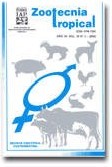
|
Zootecnia Tropical
Instituto Nacional de Investigaciones Agrícolas Venezuela
ISSN: 0798-7269
Vol. 26, No. 4, 2008, pp. 411-419
|
 Bioline Code: zt08077
Bioline Code: zt08077
Full paper language: Spanish
Document type: Review Article
Document available free of charge
|
|
|
Zootecnia Tropical, Vol. 26, No. 4, 2008, pp. 411-419
| en |
Review: The use of coffee pulp in animal feeding
Salazar, Adrianyela Noriega; Acuña, Ramón Silva & de Salcedo, Moraima García
Abstract
The processing of the cherry coffee generates the pulp, which improves its nutrimental characteristics once it
is placed in a container with anaerobic environment to ferment, so it becomes of special importance for animal
feeding. This work revises the goodness and restrictions of the pulp in animal feeding. During the intensive
managing of meat cattle, in the tropical countries, the use of the coffee pulp can reach between 20 and 30% in the
rations. In dairy cows, the pulp can be incorporated in levels between 20 and 40% of the concentrate and from 10
to 20% of the dry matter of the ration without diminishing the production of milk; though in steers it can reduce
the gain of daily weight. In sheeps, the incorporation of 15% of pulp does not affect the growth; the males present
better perfomance, and the incorporation of 15% of pulp treated with urea and seed of soybean, did not affect the
carcass weight. For the tilapias of the Nile, there was a greater increase of weight with mixture of ensiled pulp of coffee, without toxic effect; however, it is not suitable to use it fresh. For the Cachamay hybrid, there were
not differences in gain of weight between the alevins phase and adults, using it until 18% in the alevins phase.
For the Red Tilapia alevins, the pulp of coffee can be used until 20% without affecting the productive indexes.
In birds, the best response of metabolizable energy was obtained when the pulp was ensiled with 5% of molass.
In roosters, proportions superior to 5% of pulp of coffee, causes harmful effect in the real digestibility of the dry
matter and in the metabolizable energy of the animal. In rabbits, the pulp of coffee ensiled with molass can be
used until 85%; whereas in porks, it is possible to use 20% in the stage of growth and 15% in the stage of finished,
without causing losses in the productive parameters.
Keywords
animal feeding, monogastric, polygastric, ensiled.
|
| |
| es |
Revisión: Utilización de la pulpa de café en la alimentación animal
Salazar, Adrianyela Noriega; Acuña, Ramón Silva & de Salcedo, Moraima García
Resumen
Durante el beneficio del café se genera la pulpa, que al ser ensilada preserva sus características nutrimentales,
tornándola de particular importancia para la alimentación animal. En este artículo se revisan sus bondades y
restricciones de su uso en la alimentación animal. Durante el manejo intensivo del ganado bovino de carne en los
países tropicales, el uso de la pulpa del café puede alcanzar entre 20 y 30% en las raciones. En vacas lecheras, la
pulpa de café ensilada puede ser incorporada a niveles entre 20 a 40% del concentrado y de 10 a 20% de la materia
seca de la ración completa, sin disminuir la producción de leche; aunque, en novillos puede reducir la ganancia
de peso diaria. En ovinos, la inclusión de 15% de pulpa no afecta el crecimiento, los machos presentan mejor
desempeño y la inclusión de 15% de pulpa tratada con urea y semilla de soya no afectó el peso en las canales.
Para las tilapias del Nilo, hubo mayor aumento de peso con mezcla de pulpa de café ensilada, sin efecto tóxico;
sin embargo, no es conveniente usarla fresca. Para el híbrido Cachamay no hubo diferencias en ganancia de peso
entre las fases de alevines y adultos usándola hasta en 18% en la fase de alevines. Para los alevines de la tilapia
roja, se puede usar la pulpa de café hasta 20%, sin afectar los índices productivos. En aves, la mejor respuesta
de energía metabolizable se obtuvo cuando la pulpa fue ensilada con 5% de melaza. En gallos, proporciones
superiores a 5% de pulpa de café ocasionó efectos dañinos en la digestibilidad verdadera de la materia seca y en
la energía metabolizable del animal. En conejos, la pulpa de café puede ser utilizada hasta en 85% ensilada con
melaza, mientras que en cerdos es posible emplear 20% en la etapa de crecimiento y 15% en la de acabado, sin
ocasionar pérdidas en los parámetros productivos.
Palabras-clave
nutrición animal, monogástricos, poligástricos, ensilaje.
|
| |
© Copyright 2008 - Zootecnia Tropical
Alternative site location: http://www.sian.inia.gob.ve/repositorio/revistas_ci/ZootecniaTropical/ztindice.htm
|
|
